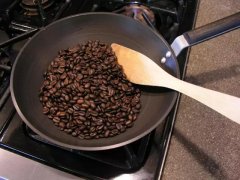Misunderstanding: why does the coffee we drink taste sour?

In recent years, more and more people like to drink coffee, and they also know more and more about the taste, aroma and taste of coffee. In the past, we must have often heard the older generation say, "Coffee must not be sour!" "Coffee is shoddy as long as it's sour!" Or something like that.
Of course, looking back from the current point of view, "sour coffee = shoddy coffee" has long been an impractical and incorrect concept. On the contrary, more and more coffee fans begin to prefer sour coffee, and even can't do without sour coffee ever since, especially among female consumers.
Of course, this is only due to the relationship between time and space, the early coffee production technology is not as modern as modern, the source is not transparent, and may also be mixed with poor flavor, unselected coffee beans. Coupled with perhaps medium-light baking, the bad taste is naturally easier to drink. In recent years, the popularity of boutique coffee has also led to the trend of individual coffee. Coffee lovers also pay more and more attention to the natural flavor of coffee, such as sour, fragrant, bitter, sweet, mellow, and so on. On the contrary, the word "sour coffee" has begun to become a representative of coffee taste.
However, whether it is the coffee teacher to the students, or the barista to the guests, the laudatory name of citric acid, fruit acid and flower smell will be used to explain the sour taste of coffee. Here's the problem. Is the acid you're talking about really the flavor of the coffee bean itself? I'm really not sure about this.
Influencing factors of Coffee acidity
Affected by the coffee raw bean itself
The acidity of coffee is affected by the quality of raw coffee beans. In terms of variety, the original Arabica is sour than the original Robusta, while in terms of elevation, coffee grown in the highlands is sour than that in the lowlands, and then the beans that have just been harvested are sour than those that have been put for a while after harvest. Good quality, high moisture content, and powerful freshly harvested beans, if they can be heated properly to produce a moderate sour taste, will make the coffee taste better and make people feel more deep.
>
Affected by the roasting degree of coffee
The acidity of coffee is also related to harvest, storage time, baking and brewing, and bitterness constitute the two major elements that affect the quality and taste of coffee. The sour ingredients in raw coffee beans are citric acid, malic acid and quinic acid. Phosphoric acid, etc., but this is not the sour taste we feel when we drink coffee. The sour taste we taste mainly comes from the acid produced in the baking process.
Most bakers will think that deep baking will increase the bitterness and destroy the sour taste, and shallow baking can experience the sour taste more clearly. In fact, such an idea is really wrong. Shallow roasting can easily lead to uneven internal baking of coffee beans, that is to say, in the shallow roasting stage, the internal dehydration of coffee beans is not clean enough, and the beans are extremely hard. The acidity of such coffee is often not round enough, with a kind of irritation in the acid, not high sweetness, not strong mellow, and the aroma is often mixed with a kind of grass flavor.
The sour taste of shallow roasted coffee can also be defined by technology, that is, the so-called PH value (pH value). The PH of coffee drinks depends on the degree of roasting. For breakfast coffee with shallow roasting degree, the pH value of Full City is between 4.5 and 4.7, the pH value of medium and deep roasted coffee is about 5 to 5.5, and the PH of deep roasting (Dark Roast) is above 5.5. As far as ordinary people's taste buds are concerned, when the pH value of the beverage exceeds 5.5, it is difficult to detect the sour taste. For drinks with a pH value below 5, it is easy to drink sour taste, so shallow baked beans will have a sour taste.
To sum up, all the shallow roasting of coffee is sour, which is the wrong taste released under the wrong roasting degree. The roasting degree is inversely proportional to the sour taste. The deeper the coffee is, the less sour the coffee is, and the more sour the beans are.
>
Affected by the water temperature of brewing coffee
The temperature of brewing coffee also has an effect. Water with a lower temperature is certainly more likely to make sour coffee than a slightly higher water temperature. I am afraid that the sour people had better finish the coffee while it is hot, otherwise the sour taste of the coffee will appear as the temperature drops.
Choose coffee beans according to taste
In fact, whether the coffee acid is sour or not is not the criterion for judging whether the quality is good or bad or whether it is fresh or not. it is all a matter of subjective taste. If you are afraid of acid, you will choose deep baked beans or Asian beans, and if you are acidophilic, you will drink shallow baked beans or African beans.
If you like sour coffee with a changing sense of taste, you might as well buy light-roasted African and Central American beans:
Such as Kenya, Ethiopia, Yemen Mocha, Guatemala, Costa Rica and so on, are good sour beans.
Consumers who prefer strong, sweet coffee can choose Asian deep-baked beans or aged beans:
For example, Indonesia Mantenin, Java, Indian beans and Brazil in South America are all good choices.
It should be emphasized here that although the sour taste of Asian beans is low, they will still taste sour if they are roasted shallowly, but the Asian beans are not lively enough and feel a little sour, which is far less varied than shallow baked beans in Africa or Central America.
Small summary
1. Arabica has high acidity, Robusta has low acidity.
two。 The acidity of washed beans is high while that of sun-dried beans is low.
3. The acidity of light baking is high and that of deep baking is low.
4. The sour taste of fast baking is relatively bright, but improper handling will lead to acidity; slow baking sour taste is relatively soft, but improper handling will lead to dull.
5. When made at high water temperature, the sour taste is relatively bright, but high water temperature will reduce the acidity; when made at low water temperature, the sour taste is relatively dull, but low water temperature will increase acidity.
6. High altitude beans have higher acidity than low altitude beans.
7. Rough grinding will increase acidity, otherwise it will decrease acidity.
8. A short soaking time will increase the acidity, otherwise it will decrease the acidity.
9. Coffee without acidity is bad or even bad coffee.
The taste of coffee is simple and complex. As the saying goes, "there are a thousand Hamlets in the hearts of a thousand people." Similarly, different people have different tastes. How to find the most suitable acidity of your coffee, you need to explore in the constant taste. The sour taste of coffee describes a lively, bright flavor, which is somewhat similar to that used in wine tasting. If coffee beans lack acidity, they will lose their vitality and taste empty and boring and have no depth.
If this cup of coffee in your hand has such a sour taste, it can even make you have some pleasant associations. Then please don't hesitate to enjoy the coffee before she cools.
Important Notice :
前街咖啡 FrontStreet Coffee has moved to new addredd:
FrontStreet Coffee Address: 315,Donghua East Road,GuangZhou
Tel:020 38364473
- Prev

Common sense of coffee beans: changes in the roasting process of coffee beans
[introduction] how to drink authentic and delicious coffee is concerned by many friends who like to drink coffee. Coffee, the most important is the roasting, what kind of roasting process determines the taste of coffee, professional coffee roasting is mainly divided into which stages? During the roasting process of coffee beans, the transformation of ingredients is very complex. After all, coffee beans are organic matter, so this ingredient
- Next

How to understand coffee roasting in a simple way
I didn't know anything about roasting until years after I started working as a barista, when I realized how important roasting was to coffee quality. Today, let me briefly introduce to you what is coffee roasting? I won't go into too much detail, my knowledge reserves
Related
- Beginners will see the "Coffee pull flower" guide!
- What is the difference between ice blog purified milk and ordinary milk coffee?
- Why is the Philippines the largest producer of crops in Liberia?
- For coffee extraction, should the fine powder be retained?
- How does extracted espresso fill pressed powder? How much strength does it take to press the powder?
- How to make jasmine cold extract coffee? Is the jasmine + latte good?
- Will this little toy really make the coffee taste better? How does Lily Drip affect coffee extraction?
- Will the action of slapping the filter cup also affect coffee extraction?
- What's the difference between powder-to-water ratio and powder-to-liquid ratio?
- What is the Ethiopian local species? What does it have to do with Heirloom native species?

